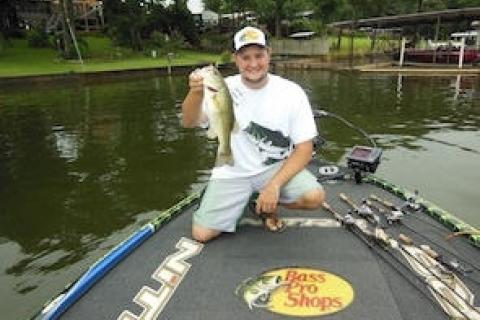
As the temperatures slowly begin to drop across the country, something happens to the bass. Many of the fish that were previously deep offshore on structure begin to make their annual migration back into the shallow water. With the water as well as the air cooling, large amounts of shad will make their way into the back of pockets and creeks. You can just about guarantee that with this movement, many of the bass are going to follow. This is a great opportunity to catch bass on a variety of different techniques, and honestly who doesn't love to find a school of bass and catch multiple fish out of one area.
When searching for schooling activity, the first step is to find large amounts of baitfish. Generally, shad are very easy to find, and you will often see them flicking and jumping out of the water. What I will do is run around to a few different promising areas where I have previous knowledge that fish and bait live nearby. Next, I will slowly work my way toward the back of the pocket or creek looking for the baitfish on the surface, as well as on my Lowrance HDS-8 Gen2 Fishfinder.
Now, most pockets or creeks you idle into will have shad in it; this can sometimes confuse and overwhelm people. Always remember that on a body of water where there is an abundance of bait fish; just simply finding the bait fish does not always mean you will find the fish. There are more ingredients that you need to look for in order to be able to have the opportunity to actually locate and trigger the bass into feeding, but the shad and baitfish are definitely the first pieces of the puzzle.
Once you have a good amount of baitfish found, it is very important that you find something specific to target to hold the fish. While sometimes the fish will be roaming open water through the schools of shad, I have found in order to catch multiple fish consistently, some sort of structure needs to be found. I picture the fish waiting relaxing in the cover, such as a brush pile or small break line and waiting for the shad to come too close. At this point, they will run out and attack. By using my GPS, I will read my contour lines and find a small break or creek channel near the groups of baitfish. If you can then find some rocks or brush along that break, then that is even better. Fishing can sometimes seem so random, so any detail you can use to fine tune what you are doing will greatly increase your chances for success.
So now that you've found the bait as well of some sort cover or structure, the final piece of the puzzle is figuring out what bait they want to eat and what presentation you need to use. Fish can be very picky creatures at times so knowing in detail what they are reacting to is very important.
One of my favorite baits to use in this situation is a SPRO Little John MD. This bait has a small profile and a very aggressive wobble that is extremely hard for a feeding fish to resist. Just give it a try and trust me, you will be very impressed. Another great quality of the bait is its versatility; it can effectively be worked in extremely shallow 1-foot-deep water, but it can also reach depths of 8 feet on 10-lb. test Trilene 100% Flouro Carbon. This depth range will let you catch those super-shallow roaming fish as well as the ones holding to cover on the bottom.
If the fish seem to be off the bottom, not relating to cover and randomly chasing bait, then a jerkbait is a great choice for triggering those suspended fish. Working baits such as the SPRO McStick 110 or a Lucky Craft Pointer SP with an erratic stop-and-go quick-twitching action is always something I will try in order to trigger fish into biting. One of the keys with these jerkbaits is the fact that they suspend letting them reach a little deeper depths and creating an easy meal for the fish to pick off in between twitches.
Now, if they are closer to the surface, then a floating jerkbait might be a better way to go, or possibly even a topwater lure. So keep an open mind and don't be afraid to switch it up a little when you are trying to figure out what the fish want. Even Alabama rigs can be deadly in the late summer to early fall transition, so don't be afraid to chuck that big thing around as well.
Always remember the key pieces to the puzzle when searching for these schooling fish or really any fish in general no matter what time of year it is. You need to have bait fish, a population of bass, some sort of structure or cover for the fish to position on, and then simply find the bait that triggers them to strike, and you've got it made. So head over to Bass Pro Shops; no matter what you're trying to catch, they have what you need to get you out on the water and putting fish in your boat. I'll see you on the water!!!
by Joey Nania
- 3004 views

